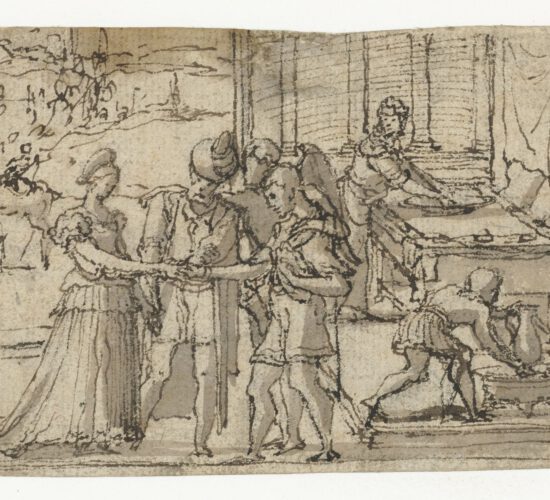Summary
The Restitutions Committee has assessed the application of the heirs of Arthur Feldmann (1877-1941) for restitution of the drawing The Marriage of Tobias and Sara (1540-1545) by the artist Pieter Coecke van Aelst (I) (RP-T-1964-44) on the basis of the recent investigation by the Restitution Expertise Centre (ECR). According to the Committee, it has emerged from this investigation that in all probability the drawing came from the private collection of the Jewish collector Arthur Feldmann of Brno. It has also been established from the investigation and numerous witness statements that it is sufficiently plausible that Feldmann lost the drawing involuntarily on the day of the German invasion of Czechoslovakia, 15 March 1939. On that day, the Gestapo raided the large detached family home of the Feldmann family and all possessions, including the art collection, were confiscated.
After the Second World War, the drawing was put up for sale by auction at Sotheby & Co in London on 16 October 1946. At the sale, the drawing by Coecke van Aelst was part of the same lot (no. 42) as the sketch Woman Standing with Veil by Hendrick Goltzius, about which the Committee issued advice on 15 May 2006 to grant the restitution application (RC 1.32). Both drawings were purchased by ‘Scharff’. After undergoing a number of ownership changes, the Coecke van Aelst drawing was purchased by the Rijksmuseum Amsterdam in 1964.
The notes on the back of the drawing are an important indication that the drawing was previously in the Feldmann Collection. These notes are very probably in Arthur Feldmann’s handwriting, as emerges from an explanatory note by Dr Stijn Alsteens in the report by the Protection Worthiness Assessment Committee (TCB), which was asked for advice by the Cultural Heritage Agency of the Netherlands (RCE). Furthermore, the ECR investigation recently examined four annotated copies of Sotheby & Co’s sale catalogue that accompanied the auction in London in 1946. Three well-known art historians and a reputable art dealer noted that the drawing had belonged to the Feldman Collection.
The work is currently held by the Dutch State, which will never invoke acquisition in good faith. The Committee therefore did not investigate this aspect. The Committee has no task in the implementation of the Heritage Act and it therefore took no note whatsoever of the TCB’s advice. The Committee has advised the State Secretary for Culture and Media to restitute the drawing The Marriage of Tobias and Sara to the heirs of Arthur Feldmann.
